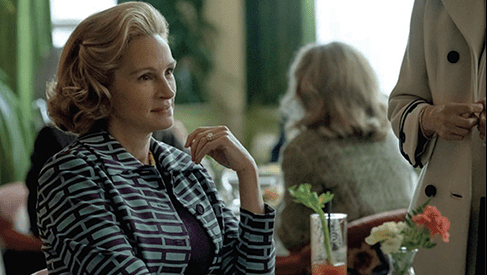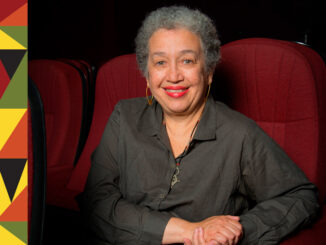
By Peter Tonguette
Fifty years ago, the Watergate scandal gripped Americans of every political stripe, assured the fame of the Washington Post reporters Bob Woodward and Carl Bernstein, and culminated with the demise of the presidency of Richard M. Nixon.
Picture editors Lauren Connelly, ACE, Joe Leonard, ACE, and Franklin Peterson have helped recreate that turbulent moment in American history with the new limited series “Gaslit,” which uncovers the backstories of many seemingly tangential figures who were part of, or became wrapped up in, Watergate — including Martha Mitchell (Julia Roberts), the spouse of Attorney General John N. Mitchell (Sean Penn); White House Counsel John Dean (Dan Stevens); and White House operative G. Gordon Liddy (Shea Whigham) — whose stories are as compelling as that of the president the scandal felled. The eight-part series, created by Robbie Pickering and based on the first season of the Slate podcast “Slow Burn,” debuted on Starz earlier this year.
Five decades ago, however, editors Connelly, Leonard, and Peterson weren’t watching the Watergate hearings on television. In fact, they weren’t even born.
“The only thing I knew about Watergate was [Woodward and Bernstein’s book] ‘All the President’s Men,’ and my dad met John Dean once,” said Leonard, 42. “My dad was the head of a speaking series [at Miami University in Ohio], . . . and he invited John Dean to speak after the whole thing.”
Peterson, 40, didn’t have too much familiarity with the scandal, either. “I was not a fan of history,” he said. “As a kid, we had terrible history teachers, so I knew very little about the actual mechanics of it all.”
As a native of the Washington, DC, area, Connelly, 38, was around the corridors of power for a good chunk of her life. “My dad worked in the government,” she said. “I know he and my mother greatly followed Watergate.” Even so, she was born too late to have any recollections of the whole sorry episode. “I knew about a lot of political things growing up,” she said. “But I don’t have any personal memories of Watergate.”
Yet for the picture editors, coming into the material cold turned out to be an advantage. After all, no viewers under 50 would have had any firsthand familiarity with Watergate, either.
“It definitely helped me identify where things were confusing,” Connelly said. “I didn’t really do a ton of pre-research or anything like that.” Consequently, if a scene didn’t make sense to her, she knew it might not make sense to modern audiences, either. “If I’m reading a scene and something is confusing, or there is terminology being used that I wasn’t familiar with, that actually was helpful in knowing what we needed to explain,” she said.
In fact, “Gaslit” centers on what Leonard calls “the unwritten stories of Watergate” — the experiences of what might seem to be peripheral players. None was more important than Martha Mitchell, whose unvarnished, press-friendly nature — she had turned up on the sketch comedy show “Laugh-In” and was a celebrity of sorts in her time — led Nixon officials to plot against her; she was kidnapped and drugged for fear she would divulge details about the scandal.

“Upon reading Episode 3, where she is assaulted and drugged, there is something, as a woman myself, about being gaslit and … you’re saying the truth and [being told] it’s not true, that really struck a chord with me,” Connelly said. “She is, in history, a very flawed individual, but Julia’s performance of her is incredible. To see such a strong woman stick to her guns, and insist on telling the truth no matter what the men around her are doing to her physically or saying about her — I loved that.”
Martha Mitchell is “the heart” of the series, Peterson said. “In each episode, even if we don’t always have Martha having the largest roles in all of them, we come back to her, and we keep coming back to that trajectory of her relationship with [her husband] John, her relationship with her daughter, and where she sees herself and where her dreams sort of went.”
Although “Gaslit” is focused on what might be called the Watergate scandal’s B-team, the picture editors stressed that each character, no matter how complicated, imperfect, or even villainous, needed to come across in full: not as caricatures, but as human beings.
“As editors, and as filmmakers and as actors, we’re approaching it from a place of pretty extreme empathy, or trying to,” Leonard said. “If we spend enough time doing it, then of course you will start to understand and fill out these characters.”
Added Peterson: “We’re dealing with people whose whole lives are being upended. . . . It’s someone who has a home life, and they have things they’re thinking about, and the prospect of going to jail or turning on their friends and all of that is stuff that I think we all really personally responded to.”
Retaining some basic sympathy for several key characters was essential, as Connelly found while cutting Episode 3. “There used to be a scene where [John Dean] actually broke up with” his wife Maureen Dean, played by Betty Gilpin, Connelly said. “And there was no coming back for this character once he did that. It was pretty bad for anyone liking him. Essentially, what we ended up doing was restructuring that entire episode to make it a fight and not have him break up with her, which changed the trajectory of people liking him for, I think, the rest of the series. That’s something the three of us talked about a lot in terms of making sure we felt for him, despite all of his wrongdoing.”

Close collaboration between the editors was essential because of the way the show was shot: Rather than shooting an episode at a time, creator Pickering and director Matt Ross completed all material featuring a given actor or using a given location. That meant that footage was fed into multiple episodes simultaneously.
“We’re shooting it like a feature,” Peterson said. “In essence, you’re basically shooting out actors, you’re shooting out locations. The benefit is production gets to say: ‘Everything that happens in the Oval Office we can shoot out in two, three days. Everything that we need with Julia Roberts, we can shoot out in her three weeks.’”
While the editors each had their own individual episodes to focus on, the team adopted a collaborative approach. “At the end of each week, we would all send our scenes to the director,” Connelly said. “But, before we did, we would screen them all together in the screening room at the facility so we could all see where everyone was at and just get a feel for the show as a whole. Because things were coming in piecemeal, I think it was incredibly helpful.”

Among the earliest scenes to be shot were decidedly dramatic ones featuring Martha and John Mitchell. When subsequent scenes called for a zanier or more comical tone, the editors had to assure that the show didn’t lurch from one extreme to another. “You don’t get a full episode until far later in the process,” Peterson said. “While all of our dramatic scenes may be humming and singing, suddenly we interject some of our lighter scenes, some of our more comedic scenes, and that now needs to shift.”
One constant throughout the process was director Ross who, in an unusual turn for a limited series, directed all eight episodes. “Matt really set the tone,” Leonard said. “It did make it easy in terms of the process of us finding the show during production.”
Connelly praised Ross and Pickering as the “two visionaries at the helm.” “It’s always a pleasure when you can have consistent vision throughout a project,” she said. “This one is unique where we had a director and the showrunner both throughout the process.”

With its mixture of historical recreation and imaginative elaboration, “Gaslit” aims to enlighten viewers who know just a little about Watergate — and to freshen the memories of viewers who lived through what Nixon’s successor, President Gerald R. Ford, once called “our long national nightmare.” “Our attention spans are so short now that we can barely remember what happened last week,” Peterson said. “Then to be kind of reminded: ‘Oh yeah — remember the giant scandal that actually took down a president?’”
In the end, though, the editors helped put a human face on the scandal.
“You are reminded that these are just people, that these same types of people work in government or corporations, and these scandals are not these big, glamorous heists that some films portray them to be,” Connelly said. “These are just people making bad decisions.”






